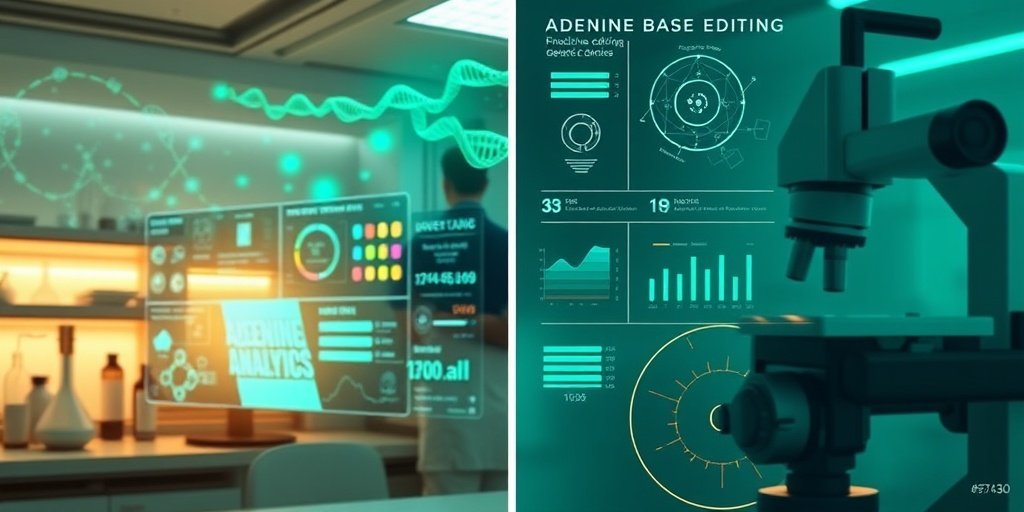⚡ Quick Summary
This study introduces BEDICT2.0, a deep learning model designed to predict adenine base editing efficiencies across various cellular contexts. The model demonstrates strong predictive capabilities, achieving correlations of R = 0.60-0.94 in cell lines and R = 0.62-0.81 in murine liver, highlighting its potential for correcting pathogenic mutations.
🔍 Key Details
- 📊 Dataset: 2,195 pathogenic mutations, 12,000 guide RNAs
- 🧬 Technologies used: SpRY-ABEmax and SpRY-ABE8e
- ⚙️ Model: BEDICT2.0 (deep learning)
- 🏆 Performance: Correlation in cell lines (R = 0.60-0.94), liver (R = 0.62-0.81)
🔑 Key Takeaways
- 🔬 Adenine base editors (ABEs) can convert A•T to G•C base pairs, offering a method for gene correction.
- 📈 Strong correlations were found between in vitro and in vivo datasets, indicating model reliability.
- 💡 BEDICT2.0 provides a robust framework for predicting editing efficiencies in diverse cellular environments.
- 🌱 Potential applications include correcting a significant fraction of pathogenic mutations.
- 🧪 Study conducted using both cell lines and murine models to validate findings.
- ⚠️ Minimal bystander effects were observed with optimal sgRNA-ABE combinations.
- 📅 Published in Genome Biology, 2025.

📚 Background
The advent of gene editing technologies has revolutionized molecular biology, particularly with the development of adenine base editors (ABEs). These tools allow for precise modifications of the genome, specifically converting A•T base pairs to G•C. However, the efficiency of these edits can vary significantly based on the target sequence and cellular context, necessitating the development of predictive models to optimize outcomes.
🗒️ Study
This study aimed to enhance the understanding of adenine base editing by conducting extensive base editing screens using SpRY-ABEmax and SpRY-ABE8e. Researchers targeted a total of 2,195 pathogenic mutations with 12,000 guide RNAs, assessing the editing efficiencies in both cell lines and murine liver. The goal was to develop a computational model that could accurately predict editing outcomes across different cellular environments.
📈 Results
The results revealed a strong correlation between the in vitro datasets generated from HEK293T cells and the in vivo datasets from murine liver, with Spearman correlation coefficients ranging from 0.83 to 0.92. The newly developed BEDICT2.0 model demonstrated high predictive accuracy for adenine base editing efficiencies, achieving correlations of R = 0.60-0.94 in cell lines and R = 0.62-0.81 in the liver.
🌍 Impact and Implications
The implications of this research are profound, as it confirms the potential of adenine base editing to correct a large fraction of pathogenic mutations. The BEDICT2.0 model not only aids in identifying effective sgRNA-ABE combinations but also minimizes unintended bystander effects, paving the way for safer and more efficient gene editing strategies in therapeutic applications.
🔮 Conclusion
This study highlights the significant advancements in predicting adenine base editing efficiencies through deep learning. The development of BEDICT2.0 represents a crucial step towards optimizing gene editing technologies, with the potential to transform therapeutic approaches for genetic disorders. Continued research in this area is essential to fully realize the benefits of these innovative tools in clinical settings.
💬 Your comments
What are your thoughts on the advancements in adenine base editing and the role of deep learning in predicting editing efficiencies? We would love to hear your insights! 💬 Leave your comments below or connect with us on social media:
Predicting adenine base editing efficiencies in different cellular contexts by deep learning.
Abstract
BACKGROUND: Adenine base editors (ABEs) enable the conversion of A•T to G•C base pairs. Since the sequence of the target locus influences base editing efficiency, efforts have been made to develop computational models that can predict base editing outcomes based on the targeted sequence. However, these models were trained on base editing datasets generated in cell lines and their predictive power for base editing in primary cells in vivo remains uncertain.
RESULTS: In this study, we conduct base editing screens using SpRY-ABEmax and SpRY-ABE8e to target 2,195 pathogenic mutations with a total of 12,000 guide RNAs in cell lines and in the murine liver. We observe strong correlations between in vitro datasets generated by ABE-mRNA electroporation into HEK293T cells and in vivo datasets generated by adeno-associated virus (AAV)- or lipid nanoparticle (LNP)-mediated nucleoside-modified mRNA delivery (Spearman R = 0.83-0.92). We subsequently develop BEDICT2.0, a deep learning model that predicts adenine base editing efficiencies with high accuracy in cell lines (R = 0.60-0.94) and in the liver (R = 0.62-0.81).
CONCLUSIONS: In conclusion, our work confirms that adenine base editing holds considerable potential for correcting a large fraction of pathogenic mutations. We also provide BEDICT2.0 – a robust computational model that helps identify sgRNA-ABE combinations capable of achieving high on-target editing with minimal bystander effects in both in vitro and in vivo settings.
Author: [‘Kissling L’, ‘Mollaysa A’, ‘Janjuha S’, ‘Mathis N’, ‘Marquart KF’, ‘Weber Y’, ‘Moon WJ’, ‘Lin PJC’, ‘Fan SHY’, ‘Muramatsu H’, ‘Vadovics M’, ‘Allam A’, ‘Pardi N’, ‘Tam YK’, ‘Krauthammer M’, ‘Schwank G’]
Journal: Genome Biol
Citation: Kissling L, et al. Predicting adenine base editing efficiencies in different cellular contexts by deep learning. Predicting adenine base editing efficiencies in different cellular contexts by deep learning. 2025; 26:115. doi: 10.1186/s13059-025-03586-7